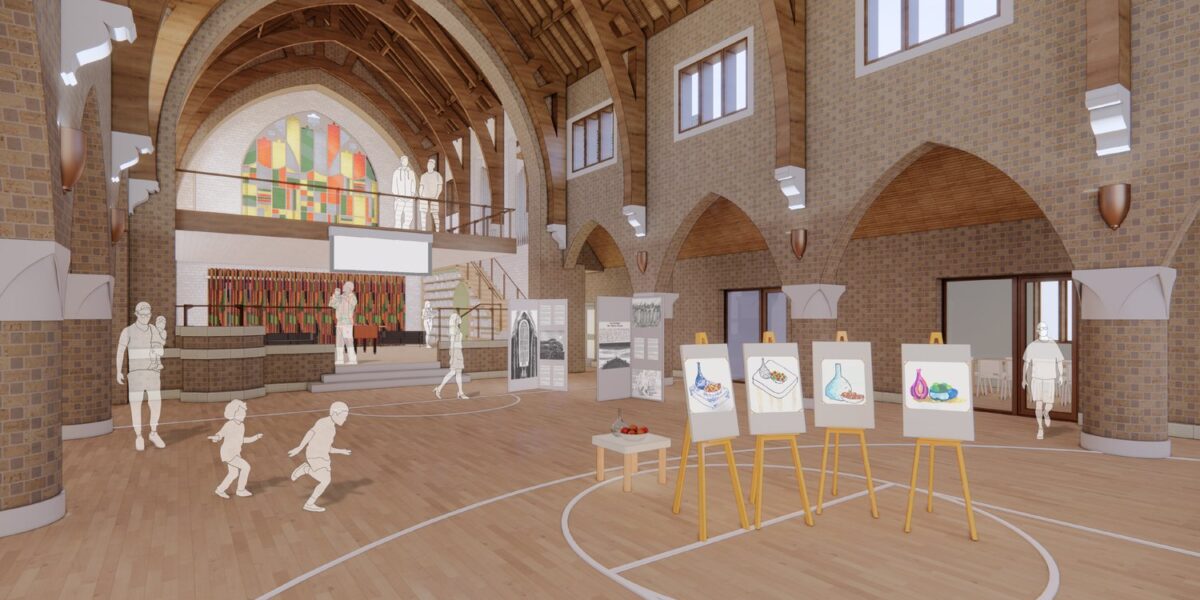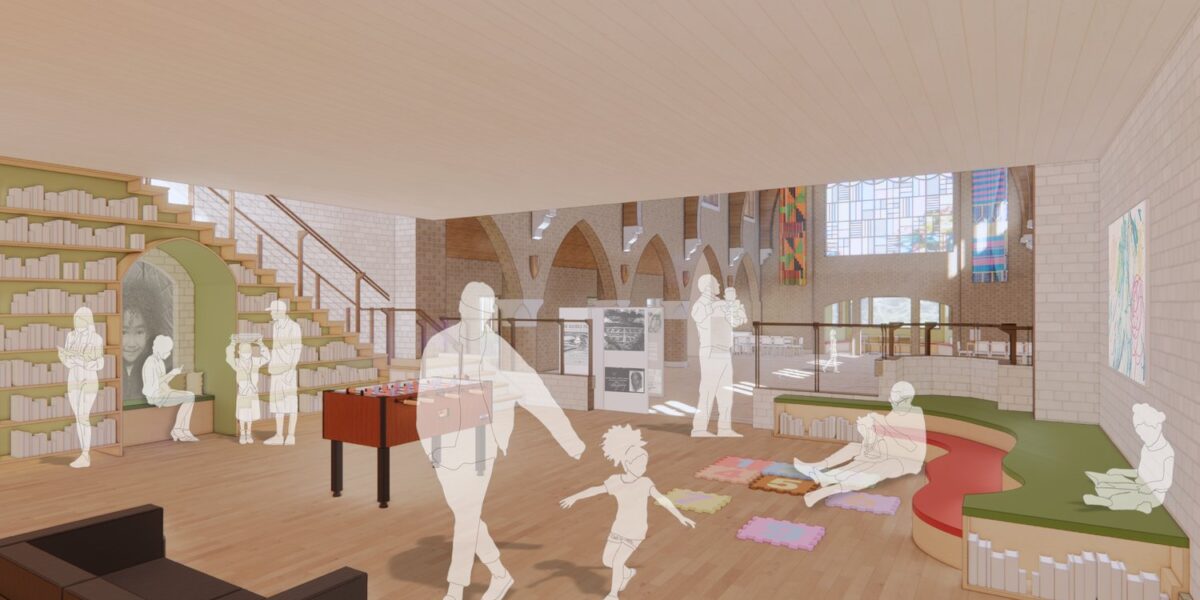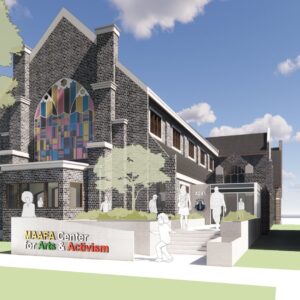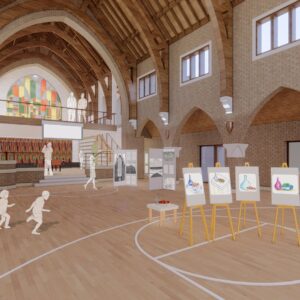In a Nutshell
What: Q&A with Marshall Hatch, Jr., the co-founder and executive director of the MAAFA Redemption Project. MAAFA provides a continuum of support to young people and is embarking on a facility renovation project that will expand its capacity to support young people in making healthy decisions for their futures. The renovated facility will also provide the community with a high-quality space for intergenerational art programming and community organizing.
Sectors: Workforce Development, Youth Services, Arts and Culture
Location: Chicago, IL (West Garfield Park)
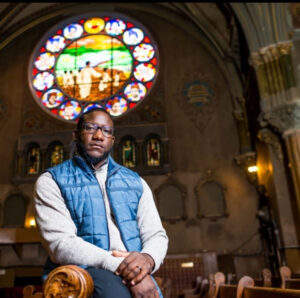 Marshall Hatch, Jr. knows what it feels like to be written off. At age 15, Hatch was expelled from high school, discarded as a lost cause by adults who assumed he was beyond redemption. With the support of his family and church community, however, the traumatic experience was a temporary setback instead of a permanent impediment. In the 20+ years since then, Hatch has gone on to earn a bachelor’s degree in political science and religious studies; two master’s degrees in social work and divinity; and is now pursuing a doctorate in philosophy.
Marshall Hatch, Jr. knows what it feels like to be written off. At age 15, Hatch was expelled from high school, discarded as a lost cause by adults who assumed he was beyond redemption. With the support of his family and church community, however, the traumatic experience was a temporary setback instead of a permanent impediment. In the 20+ years since then, Hatch has gone on to earn a bachelor’s degree in political science and religious studies; two master’s degrees in social work and divinity; and is now pursuing a doctorate in philosophy.
More importantly, he’s channeled his experience into his role as executive director of the MAAFA Redemption Project (MAAFA), a nonprofit he co-founded in 2017 that aims to improve the quality of life for Black and Brown youth and their families in the West Garfield Park neighborhood where he grew up on Chicago’s West Side. MAAFA accomplishes this through a continuum of support that includes dormitory-style housing for participants, workforce development training, character/spiritual development, and wraparound supportive services.
Operating in a former church, MAAFA is now embarking on a significant renovation of the facility that will create the MAAFA Center for Arts and Activism (MAC). Once complete, the MAC will provide MAAFA with a high-quality venue to offer intergenerational arts programming coupled with grassroots activism training and facilitation – both of which were identified by community members as priorities in the West Garfield Park neighborhood – in addition to high-quality space for the organization’s existing programming. The project, which is being supported by IFF’s Real Estate Solutions team and an IFF predevelopment loan, is part of a larger initiative to develop the Sankofa Wellness Village, a series of interconnected capital projects and social enterprises designed to strengthen a key commercial corridor in West Garfield Park.
As construction begins, IFF talked to Hatch about what led him to co-found MAAFA, how the organization is working to overcome systemic barriers to opportunity for young people on Chicago’s West Side, the role the arts can play in strengthening West Garfield Park, and more.
IFF: Can you talk about your background and what motivated you to devote your time, energy, and talents to MAAFA’s work?
Hatch: MAAFA’s work is based in West Garfield Park and our church, New Mount Pilgrim Missionary Baptist, has been in the neighborhood for 30 years. My father is the pastor there, and our whole family has been involved with serving and ministering in the neighborhood since we moved there when I was five.
In 2000, the church installed two rose windows that are 25 feet in diameter, and one of them is known as the Maafa remembrance window – which is the largest iconic display of the Middle Passage in the world. Maafa is a Swahili word that means overcoming great catastrophe, and the window is a call to remember the history associated with it and to try to redeem that history. That became the spiritual and philosophical grounding of the MAAFA Redemption Project, which was founded to support the young people in the neighborhood.
Before MAAFA was launched, I was involved in a program through the church where we opened a gym on Friday nights for basketball. That’s the most dangerous time of the week for young people in the community, and our goal was to create a safe place for young men, in particular. That went on for several years before we started developing wraparound services and supports for that population and formalized the work with the founding of MAAFA.
IFF: How did MAAFA determine the mix of programs and services that were most needed by young people in the community?
Hatch: Part of it was just responding to need, which is what ministry is. We had developed strong relationships in the neighborhood, and one of the things we heard from young people was that they wanted jobs. And so, we began developing partnerships across the city to create pipelines and pathways to jobs, and education was an important component of that. Many of the guys we were working with were also housing insecure, and the church had already invested in properties in the neighborhood, so we were able to house folks immediately.
The lifeblood of our work, though, is relationship building. And that gives us the opportunity to engage in what we call spiritual life coaching. That’s mentoring, but there’s also a mental health component to the approach to help young people process previous trauma. Many of the life coaches on our staff have been involved with the justice system throughout their lives, and they come back from that and really want to pour themselves into young folks so that they don’t have to make the same mistakes. Overall, we want to give them the tools they need to make healthy decisions.
“The lifeblood of our work is relationship building. And that gives us the opportunity to engage in what we call spiritual life coaching.”
IFF: What makes West Garfield Park a special place worth investing in through MAAFA’s work?
Hatch: There are common narratives about the neighborhood, like having the highest number of shootings in the city and one of the highest rates of school expulsion during the pandemic. Those narratives are based in fact to an extent, but they certainly don’t tell the whole story. West Garfield Park happens to be one of the youngest neighborhoods in Chicago, with about 57 percent of residents under the age of 35, and that means there’s tremendous potential for the future. The neighborhood also has beautiful architecture and park space, and there’s a rich history of community organizing.
Sankofa means that in order to move forward, you must first go back and reclaim and restore what’s been lost or forgotten, and that’s really what our work and the broader community development work that we’re a part of is focused on. The neighborhood had lots of amenities and plenty of job opportunities at one point. And while much of that slipped away, it provides a vision of what can be again, and that’s worth fighting for. But to get there, and to lay the foundation for coming generations, things have to be done differently.
IFF: After seven years leading MAAFA, what are some of the most important lessons you’ve learned?
“I’ve learned that you can’t really do this work effectively without a vision for community development, because direct service and community development have to go hand in hand. If you’re just providing services, it’s like putting a Band-Aid on a bullet wound.”
Hatch: I’ve learned that you can’t really do this work effectively without a vision for community development, because direct service and community development have to go hand in hand. If you’re just providing services, it’s like putting a Band-Aid on a bullet wound. It doesn’t matter how much money you throw at the symptoms, because the underlying problem will continue to fester.
Something else that’s important to note is that the young people who come to us are tired of the subculture that only produces death, despair, and falling into the trap of the criminal justice system. They want something different for themselves and their loved ones. That’s probably 97 or 98 percent of young people in the community. Then you have young folks who are on the fence about the direction they’re headed, and they can be swayed either way. It’s up to local leaders to provide a vision that’s compelling enough for them to see themselves as a part of it and to make better decisions.
I don’t know that there is a perfect model for this work, but we’re working with human beings, and development and growth is not linear. It’s important to be patient and keep doing what we believe works best to support the young people we work with without being influenced by voices from outside of the community that brand us as nothing more than a gun violence prevention program. Ella Baker was an organizer during the Civil Rights movement who referred to the “spade work” of organizing communities to build people and organizations that will outlive all of us. That what’s needed in West Garfield Park, and I’ve learned to focus on that while maintaining a sense of inspiration and hopefulness about the future.
IFF: To your point earlier about the importance of having a vision for community development while providing direct services, how does MAAFA’s work connect to the community’s broader plan for equitable redevelopment?
Hatch: The young men in our programming recite these words every day, “We recognize that we cannot redeem our families and our communities until we first redeem ourselves. Therefore, our mission is to invest in the mind, body, and spirit so that we may repair and rebuild our city one life at a time.” Baked into that motto and mission statement is the goal and the call for individual redemption and transformation, and then connecting that individual transformation to a communal transformation.
We’ve been grateful to be a part of creating the Garfield Park Right to Wellness Collaborative, which received the $10 million Chicago Prize from the Pritzker Traubert Foundation to help restore the neighborhood with the Sankofa Wellness Village. The constellation of projects include a Federally Qualified Health Center, a credit union, a social innovation hub, a community grocer initiative to target food insecurity, and the MAAFA Center for Arts and Activism – all of which support the broader goal of community development in West Garfield Park.
“With the [MAAFA Center for Arts and Activism], the goal is not just to produce art, but for the art to serve as a reflection of who we are. The center will serve as one of the central locations in the neighborhood where people can come and see themselves and their community differently.”
IFF: What will the MAAFA Center for Arts and Activism bring to West Garfield Park?
Hatch: Our project will restore an old Episcopal church to provide a space where residents can engage in intergenerational art making, relationship building, community organizing, political education, and civic empowerment. When I was in graduate school at the University of Chicago, one of the things that I was drawn to was the idea of communal efficacy, which is just a fancy way of saying the belief that a community has in itself to effect change. Everything starts with faith or a belief that the community can do it, and we believe that art can play a transformative role in inspiring people, giving them hope, and bringing them together around a collection of ideas and values that’s in the DNA of our church and, by extension, MAAFA.
With the new center, the goal is not just to produce art, but for the art to serve as a reflection of who we are. The center will serve as one of the central locations in the neighborhood where people can come and see themselves and their community differently. The space will be multipurposed, with the programming we’re already offering based there. The young people will eat there, engage in fellowship, get the mental health support they need, among other examples, and all of the programming is going to be multiplied with the renovation of the facility in terms of the number of people we can serve.
The renovated building is also going to help us build out a pilot program we started last year called Beautiful Seed, which is the sister program of MAAFA. We’re excited to be able to reach out to the young women of color in the community too. The Sankofa School for the Arts’ programming will also be housed there, which will serve kids as young as four. We’ve recently piloted a program funded by the Blackhawks Foundation where the kids engage in content creation, ballet, modern jazz, hip hop, and musical theater, along with a class on DJing. What we’re hoping to see is the programming taking place in the center reverberating out into the community.
IFF: Any final thoughts?
Hatch: There’s been a big focus on how institutions can support communities like West Garfield Park since the killing of George Floyd, and now we’re seeing a backlash to that movement. But for us to actually see decades of disinvestment reversed, we have to remain vigilant and double down on what we believe. We have to remain committed to doing things differently and avoid tired tropes and narratives that reinforce Black inferiority. I’m hopeful that the business community will support that. We’ve seen glimpses of that commitment, but now is the time to do more.
Tags: : Arts and Culture, Capital Solutions, Community Development, Real Estate Solutions, Workforce Development, Youth Services

